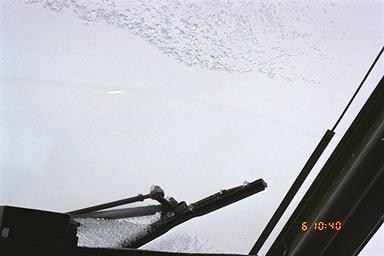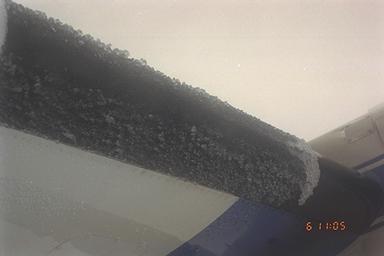
An Icing Encounter
Scott McKelvey
Weather is on the minds of every IFR pilot, and the decision to go or not go is tempered by many factors. Knowing what your limits are, and knowing when the data you have lulls you into a sense of complacency, is critical to your safety. Icing is tied with thunderstorms as the most treacherous weather we IFR pilots can encounter. Below Scott McKelvey shares his icing experience, and how it changed his outlook on weather. Scott survived without incident, we're sharing his tale with a happy ending in hopes that it will provide you some additional things to think about. We each have to make personal decisions about the risk we'll take, there's no right or wrong, just making sure there is another day of flying in our future.
Four years ago, I had just purchased my Mooney and decided to fly it down
to the Mooney Aircraft Pilots Association maintenance class being held at
the Santa Maria airport. Uneventful flight down from my home airport at Napa,
California. It rained the next night, and there were lingering clouds the following
day for my departure home. Freezing level forecast to be 7,000.
I filed an
IFR flight plan home with a routing that could be flown at 5,000 feet. Plenty
of safety margin, right! I got a full briefing and received PIREPs that icing
had been encountered in the clouds at 9,000 by the big jets. There were a number
of other reports from small planes along my route but none involved icing.
| So, off I go. I was climbing out of 4,000 somewhere before Paso Robles and went into a cloud. Immediately, the windscreen was sheathed in ice. Couldn't see a thing. Looked out both side windows and was amazed at how quickly ice was accreting on my leading edges. Very visible and damned scary. Looked like stalactites (or were they stalagmites?). I notified ATC that I was picking up ice and at that exact moment, I broke into the clear, I was through a small frontal area of clouds. |  |
I let ATC know that I was out of the clouds and in sunny skies. Stupidly, I decided to fly rather than descending immediately. Frankly, I wasn't scared because the plane was still flying, though I did see a marked decrease in indicated airspeed. I would normally be cruising at around 140 kts indicated and instead saw around 105-110. I flew my plane with the ice for a number of minutes. Thought it was a good thing to understand in case it ever happened again. What an idiot! I also partly believed that since I was no longer in any moisture, surely the ice would dissipate - nope.
 |
After a very long 10-15 minutes of flying with those conditions, I diverted and descended. I had been cruising at 5,000 feet that entire time. At less than 3,000 feet, the ice on my windscreen finally started melting. That made me feel a hell of a lot more comfortable. Shortly after that, I noticed that the ice on my leading edges was breaking away in six-inch-long chunks. |
When all of that was clear, I was relaxed and preparing for a normal arrival when suddenly big chunks of ice started coming off of my prop and hitting my windscreen. That absolutely scared the bejeesus out of me. It's the ice that you can't see that is the biggest concern.
I had about 30 hours in my Mooney at that time and about 500 hours of total time. I now have almost 1,300 hours and can tell you that experience radically changed my outlook on flying during the winter months. I thought I had followed all of the proper pre-flight risk assessments. I had chosen a routing and altitude that would have kept me well below the reported freezing levels. I had numerous outs along my route. I had not heard any reported problems along my route. Since that experience, I stay on the ground during the winter unless I can stay clear of moisture. The exception is the normal morning fog that we get at the Napa airport. I will depart through a fog layer or shoot an approach through it. Otherwise, I choose not to fly my plane.
So for me, I think I scared the possibility of ever being complacent again. It only takes once.
Scott
Copyright © 2006 Scott McKelvey, used with permission.
Images from the NASA on-line media collection